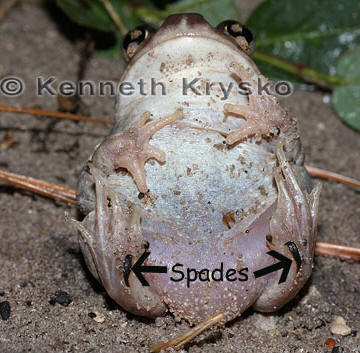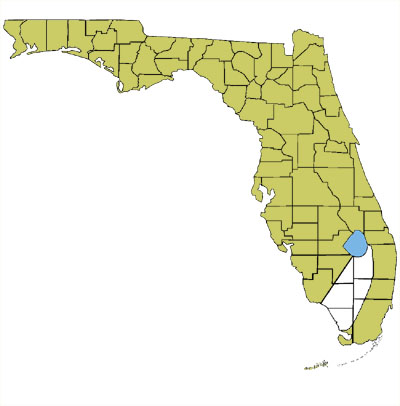Florida's Frogs & Toads
Spadefoot Toads (Family Scaphiopodidae)
_________________________________________________________
Eastern Spadefoot
(Scaphiopus holbrookii)
Eastern Spadefoot (click on small image to view larger)
Photos by Dr. Steve A. Johnson (UF) and Dr. Kenneth Krysko (FLMNH). Photos may not be used without the express written permission of the photographer. To obtain permission to use the larger photo for educational purposes, email tadpole@ufl.edu.
Size:
Usually 1.75 to 2.25 in.
Identification:
Stout body is brownish gray to nearly black; back is usually marked with two yellowish lines in an hourglass shape. Skin is relatively smooth with only small warts; oval parotoid glands are present, but not prominent, on the shoulders. Pupil of the eye is vertical. The bottom of each hind foot is equipped with a black, sickle-shaped spade (shown in inset image above).
Breeding:
March to August (possibly year round in south Florida); breeds explosively after very heavy rains. Eggs are laid in band-like strings attached to vegetation but may be found in small clusters. Breeding call is a low pitched, prolonged mwaaaah. To hear frog calls, visit the USGS Frog Call Lookup and select the species you want to hear from the common name drop-down list.
Diet:
Ants, beetles, caterpillars, flies, spiders, millipedes, and other invertebrates.
Habitats:
Found throughout Florida, with the exception of the south-central region and the middle Keys, burrowed in sandy soils in a wide variety of urbanized, agricultural, and natural habitats with loose soils. Breeds in shallow, extremely temporary ponds and marshes.
Map by Monica E. McGarrity - may be used freely for education.
Go Back to Florida's Frogs - All Regions




